Native Elements: Graphite
 Diagnostic Card.
Diagnostic Card.
C
Crystal system hexagonal
Hardness 1-2 (very soft)
Specific weight 2,09-2,26
Cleavage is perfect
fracture splintery
Black color
Powder color is dark gray
diamond Gloss

Graphite - modification of carbon (C). Luster metallic or dull. Opaque. Colour: steel-gray to iron-black. Dash gray. Fracture is uneven. Cleavage is perfect. At the touch of greasy, greasy. The crystals (hexagonal system) are very rare. Usually, scaly form aggregates. It is used as a material for the manufacture of pencils and crucibles, as well as anti-friction solid lubricants. Distribution Area: Bavaria (Germany), Styria (Austria), about. Madagascar, the Korean peninsula, the CIS, the USA.
 This mineral composed as diamond, one of carbon black crystallizes as foliated masses perfect cleavage. The last property he owes the crystal structure where the carbon atoms are arranged in a layered hexagonal lattice. Links inside layer is very strong, and between the layers - weak. Graphite color - black. The exceptionally well-formed crystals are rare. More common plate and irregularly shaped flakes. Most common microcrystalline dense masses.
This mineral composed as diamond, one of carbon black crystallizes as foliated masses perfect cleavage. The last property he owes the crystal structure where the carbon atoms are arranged in a layered hexagonal lattice. Links inside layer is very strong, and between the layers - weak. Graphite color - black. The exceptionally well-formed crystals are rare. More common plate and irregularly shaped flakes. Most common microcrystalline dense masses.
Form crystalline precipitates. Foliated, scaly, radiating, earthy. The crystal structure. carbon ions are arranged in layers, consisting of a flat hexagonal grids, as opposed to the diamond structure, similar to a face-centered cubic. Class symmetry. Digeksagonalno bipyramid - 6 / mmm. Cleavage. Quite perfect on the basis (0001); It makes good lubricating properties (graphite grease). Aggregates. Dense, tonkocheshuychatye to foliated.
Diagnostic features.
Graphite is determined accurately on the basis of color (dark gray), softness and cleavage. But it can also be identified by the ability to leave a trace on paper. The word "carbon" comes from the Greek word "grafein" (write). Mineral soft, easily scratched with a fingernail. Not melted (burned at 3500 o C). Behavior in acids. Insoluble.
Origin.
It has a metamorphic origin, representing the end product of carbonization of organic matter. Perhaps it may also have magmatic origin, since it is found in pegmatites and hydrothermal veins.
Place of Birth.
Large deposits being developed by industrial methods, are in Sri Lanka, Madagascar, Russia, many areas of the United States, Canada, Mexico, South Korea and Germany (the famous deposits of Bohemia). Fine crystals are in perfect shape marbles Sterling Hill (NJ).
Application.
Graphite is used for the production of pencil leads, paint; refractory materials for the metallurgical industry, the electrodes and dry lubricants. Basically prefer artificially produced graphite, since it is more pure.
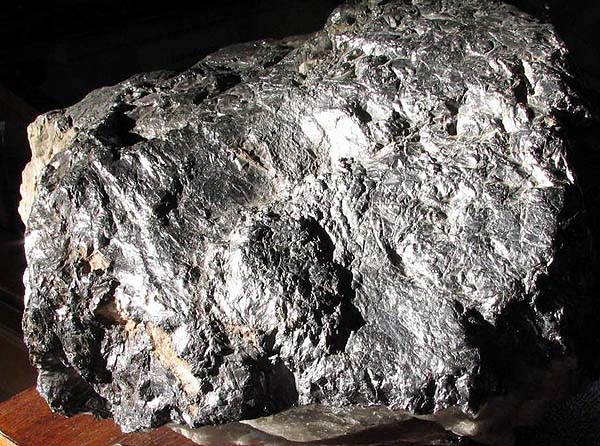
Graphite. Moragalla p-ki, Sri Lanka. Photo: © AA Evseev.

Graphite. Aliberovsky district to, Botogolsky loach, Eastern. Sayan, Wed. Siberia, Russia, CIS. 25 cm Photo:. © AA Evseev.
Native Elements: Bitumen (Russia, CIS)
Vodinskoe sulfur deposit. Photos 2007 . We thank Dmitry Davydov (Moscow) and Nicholas Belenkova (Ekaterinburg) for providing the pictures for this page. All photos were taken during a visit to Samara sulfur pits in 2007 Samara (city in the European part of Russia (CIS), on the Volga River, the administrative center of Samara Oblast until 1991 -. Kuibyshev, Russia, CIS). Pos. Novosemeykino - Kimberley S. brimstone At the latitude of the city of Kharkiv (Ukraine, CIS), a temperate climate, the district and the city of Tolyatti Zhigulyovsk (Volga River, Russia, CIS.).

Extract from the rock crystals and bitumen has to carefully
to himself not to plunge into a sticky, fragrant substance - a mineral bitumen.
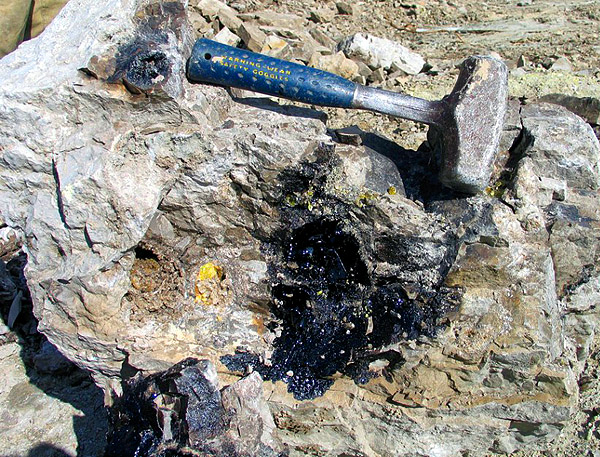
Cavities with sulfur crystals are completely filled with black liquid bitumen.
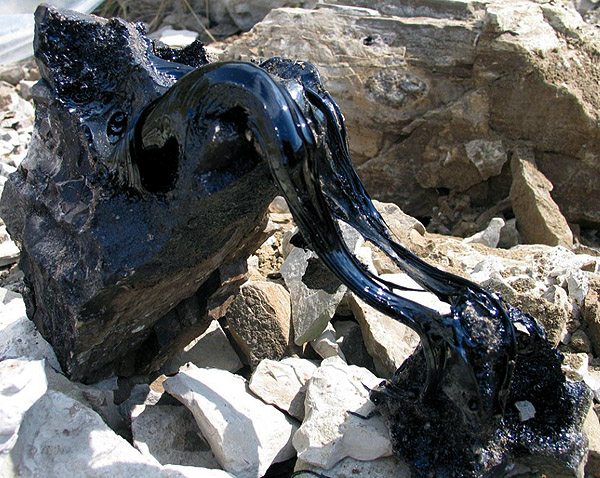
Black bitumen, an integral part of any asphalt pavement of the city (part asphalt)
"Black," the dream of every sane citizen, for example, Kharkov, Ukraine, CIS
The best and most durable coating roads and sidewalks median strip

Possible coverage of the road in the US - "American way of life", the highway
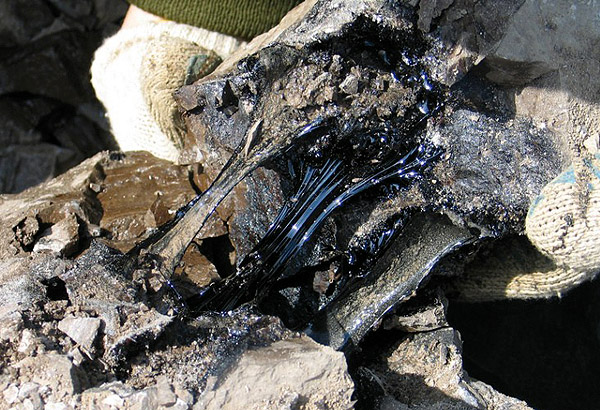
Top avtomobilyne roads and pedestrian walkways - so it is with black bitumen (granite)
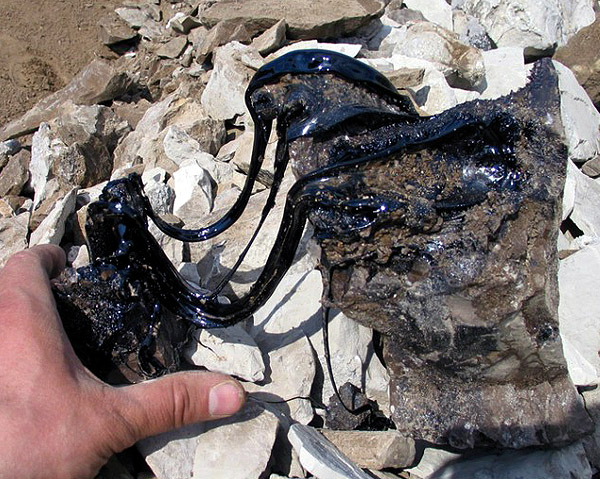
"Gorgony" black bitumen is liquid at normal temperature, is not washed with water
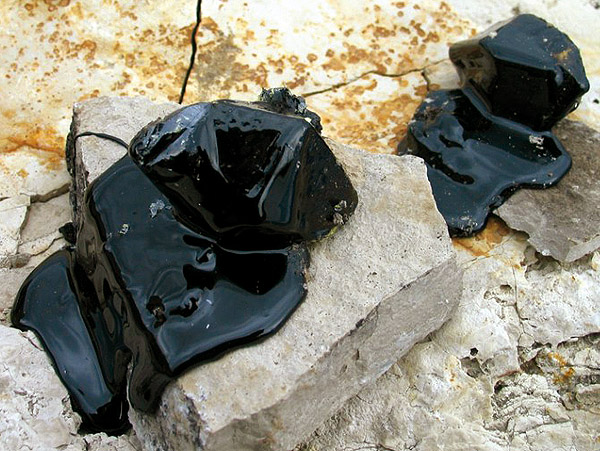
Crystals of sulfur extracted from the "bitumen" voids, it is stored online (coated with bitumen)

When laying asphalt sulfur (yellow) is extracted from bitumen - it burns in pavers
Yellow gray streets, roads and sidewalks is not a bridge - it is fragile, soft and poisons
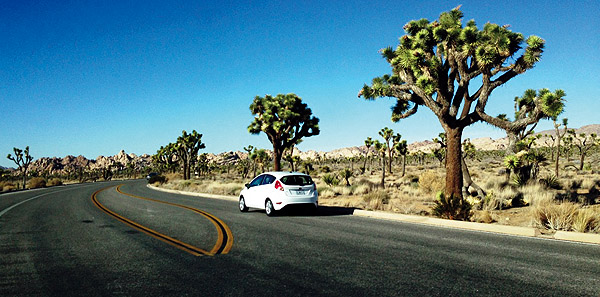
Joshua Tree (Joshua Tree National Park), Yuzhn National Park. California, USA. Photo: © Ivan Lykov.
Asphalt asphalt road - along the park "Joshua Tree" ( "Trees of Jesus"), bitumen, 2015
Dry and hot in the US highway (succulent trees like "bottle" with a supply of water, drained)
The road - the so-called terror "Soviet" prisoner (HCC USSR) on sulfur and bitumen - slaves in Spain, EU
This highway is also called "road parasites" ( "track parasites") - laying bitumen
Native Elements: Coal (Ukraine, CIS)
Coal and other industries. Ukraine - the largest CNG fuel and raw material base (industrial carbon and graphite three types, up to and including commercial): it accounts for about 44% of underground production and about 37% of coking coal (1988). It is the fuel supplier for the steel industry, thermal power plants, chemical industry and other sectors of the economy of the European part of the CIS.


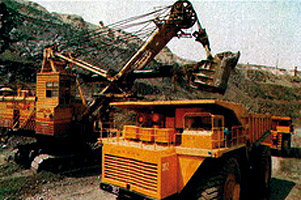 In 1988 we operated 248 mines and 5 uglerazrezov in Ukraine (the former Ukrainian Soviet Socialist Republic). In the photo - the quarry and loading of coal (carbon native crystal, spinel) Poltava Mining (Mining and Processing Plant, 1989).
In 1988 we operated 248 mines and 5 uglerazrezov in Ukraine (the former Ukrainian Soviet Socialist Republic). In the photo - the quarry and loading of coal (carbon native crystal, spinel) Poltava Mining (Mining and Processing Plant, 1989).
In Donbass (Donetsk region., South-east) are in operation 225 mines and produces 91% of coal. In the Lviv-Volyn (western Ukraine) pool operates 18 mines. In the Dnieper basin (central south-eastern part of Ukraine) brown coal developed mainly open pit (over 61% of production). Here are 5 sections and 5 pits a total annual production of 9.7 mln. Tons of coal.
Existing coal cuts are modern highly mechanized enterprises with application of modern computer technology.
The coal seams are graded categories and are characterized by a complex structure. Mean dynamic power of developed reservoirs in 1988 was 1.1 m Specific weight of the coal mining thin seams of less than 1 m is about 34% and the capacity of less than 1.2 m. - About 56%. The average depth of the development of the mines of Ukraine - 556 m (340-360 m higher than permissible and prohibitive 400 m). gas emissions - are minimal (0.7%), on the secondary cracks and leakage of volcanic gas in the earth's crust. Primary seismograph. Acceptable working conditions even for novice miners.
Real underground volcanic batholiths in yields of native and other carbon (face down on sulphides, including red cinnabar - increase power reservoirs) are processed in the mines of PO "Artyomugol" - 891 m, the software "Anthracite" 881 m, ON "Makeevugol" 926 m ON "Dzerzhinskugol" 810 m (sverglubokie). Annual deepening of mining operations is on average an average of 8 m. At depths greater than 600 m development are 164 mines, including at a depth of over 1000 m - shafts 35 (the specific weight of these extraction respectively about 39% and more than 5%). gas emissions in the mine are on adjacent to the active high-temperature volcanic fissures batholith and silo-dyke components (49.85% gas). For semi-professional and high-tech processing.
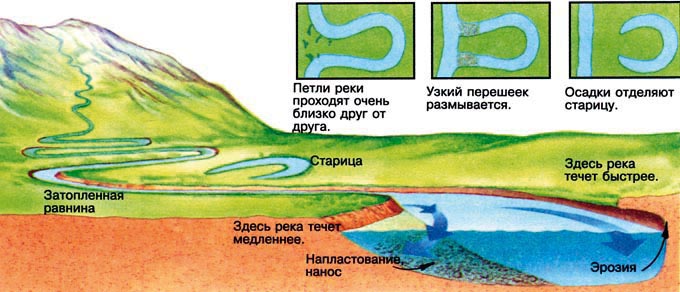

The maximum depth of the development of individual (okolobatolitovym - hear the buzzing underground volcanic magma and lava, "brewed pot") mines amounted to: him. Chelyuskintsev - 1200 m, they are. AA Skochinskiy - 1185 m "Progress" - 1133 m, them. V. Bazhenov - 1215 m, them. AG Stakhanov -. 1133 m More than 110 mines classified as category 3 and sverhkategornym gas, 106 mines are developing reservoirs, dangerous to sudden outbursts of coal and gas (directly from the batholith, ognedyshat - 99.3% of the volcanic compo- nent) . The temperature of the wall rocks at a depth of 1000 m up to 45-50 o C, which leads to the most adverse thermal (supercritical temperature) conditions at work in clearing and preparatory faces - almost impossible and unrealistic conditions of work in the mines (Tolkien - the final adventure of hobbits).
About 39% of mines have a production capacity of 2,000 tons / day (of which is produced in excess of 62% of the total coal), more than 8% of the production comes from mines with a production capacity of over 5000 tons / day. Coal mining pillar mining systems and 68% (in some associations of up to 100%); bestselikovoy on technology produced 132.5 million. tons of coal, or 75% of all production cleaning. Main cleaning equipment: mechanized complexes KM-103, CD-80, the KMT, KM-87, KM-88, KMK-97, KSU; Panel-mounted units and ANSCH 2ANSCH, plow CO-75 SET 2M uzkozahvatnye harvesters 1K-101, IK profile, SW, NH-68, "Search" -2 ". The level of mechanized mining in the mines of Ukraine reached almost 65% for slaughter capacity was 500 t / day (1988).
In the preparatory faces apply: tunneling machines (4PP-2M, RSCC) and coal-threaded systems KH-78, loading machines type 1PNB-2, 2PNB-2, NSP-ZD, IPC-3, 1PPH-5, PPH-1C, MRP-4U, drilling machine "Boom 77" rigs-1M ECU, ECU-ST, CU-1B, 2B-BUR, UBSH-252. Specific volume mechanized preparatory excavation of over 83%, including combines 35% (1988).
On the underground transport used: belt conveyors, heavy duty trucks, locomotives. Implemented by the mechanization of auxiliary operations. In 1988, coal production reached 191.7 million. Tons, including Underground 185.5 ppm t (from its coking about 78 ppm m) and 6.2 ppm outdoor T. concentrators Ukraine processed 147 ppm tonnes of coal, of which 26.3% are enriched in heavy media, and 59, 8% jigging (1988).
Available in high-quality concentrates (carbon) for the electrode industry, agglomeration of ores and the production of sulfonated coal ( "mine seed"). The ash content of 7.5-9% concentrate of coking, coal, shipped to coking, 15.4% and 27.9% to prochee- - for the needs of black, non-ferrous and powder metallurgy.
The main area of coal consumption patterns of use are coke chemistry (33.6%) and electricity (27.8%). Part of the coal is exported, municipal and own needs of enterprises and other consumers (on the production of mercury from zinovari etc. chemical and other industries).

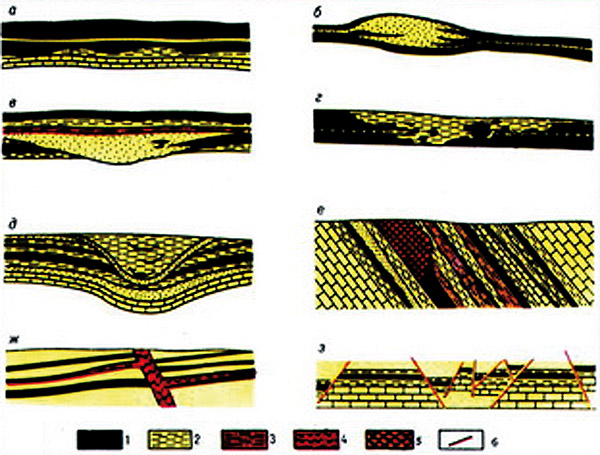
Coal seam (a soal seam, soal bed; n Kohlenfloz, Kohlenschicht; f souche de charbon, veine de houille, banc de charbon;.... And capa de carbon, estrato de carbon) - a form of occurrence of coals, a plate - and lenticular bodies with a small spread in comparison with the area of power. The coal-bearing formations, formed in large deflections prigeosinklinalnyh and folded areas (. Donetsk, Kuznetsk, Pechora, Karaganda and other pools), the power of coal seams varies from tens of centimeters to several meters (single 10-25 m); while many of the layers of power is held in the squares in the tens and hundreds of km2.
Inside the platform deposits (. Moscow Region, South Ural Russian basins, Dneprovskiy Ukraine, etc.) is more typical lenticular form coal seams with less (units - tens of km2) area of distribution and a greater degree of variability of morphology and capacities, which in deposits of some deposits in the tens and several hundred meters.
Coal seams can be simple (without layers of different rock) structure, presented homogeneous or banded (of two or more lithotypes) coals. For the most part they have a complex structure with a different number of layers of rocks. Significantly extended coal seams (deposits) is very complex structure represented by multiple alternating them in the context of the coal layers and rocks. Coal Contacts with host rocks of the coal seams can be sharp with a distinct rhythmic alternation, from the more fine-grained, bordering differences coal to coarse. As part of a gradual transition of coal at the bottom (the soil) or the roof of the reservoir to the surrounding his species through intermediate layers interbedded carbonaceous rocks of high-clay and coal.
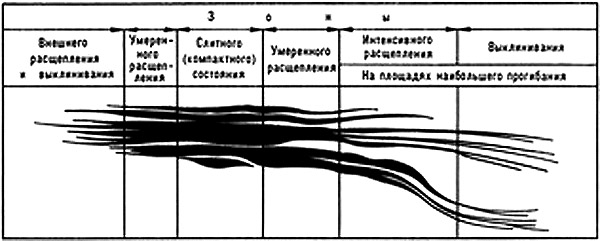
In the practice of underground mining of coal and therefore the exploration and geological and economic evaluation of coal deposits of the CIS (ex-CCCP) coal seams on the angle of incidence and power are divided into the following groups: the angle of incidence - sloping (up to 18 o), inclined (19-35 o ) high-angle (36-55 o) and steep (56-90 o); power - very thin (0.7 m) thin (0,71-1,2 m), medium power (1,25-3,5 m), strong (more than 3.51 m). The incidence angle and power of the coal seam is largely determined by its design and management methods in the roof clearing faces, mechanization of clearing works, and so on. N.
ADR 4.2

Substances capable of autoignition
Risk of fire as a result of self-ignition if packages are damaged or there is the source of the content.
May react vigorously with water
White upper half of the rhombus, red - the lower, equal size, number of ADR, the black flame
ADR 3


Flammable liquids
Risk of fire. Risk of explosion. Containers may explode when heated (ultra-hazardous - easy to burn)
Use cover. Avoid low areas of the surface (holes, depressions, trenches)
Red diamond, the number of ADR, black or white flame
ADR 2.1


Flammable gases
Risk of fire. Risk of explosion. May be under pressure. Risk of suffocation. May cause burns and / or frostbite. Containers may explode when heated (ultra-hazardous - practically do not burn)
Use cover. Avoid low areas of the surface (holes, depressions, trenches)
Red diamond, the number of ADR, black or white flame
ADR 2.2


Gas cylinder Non-flammable, non-toxic gases.
Risk of suffocation. May be under pressure. May cause frostbite (similar to a burn - pallor, bubbles, black gas gangrene - creaking). Containers may explode when heated (ultra-hazardous - an explosion of sparks, flame, matches, almost do not burn)
Use cover. Avoid low areas of the surface (holes, depressions, trenches)
Green diamond, the number of ADR, black or white gas cylinder (type "balloon", "thermos")
ADR 2.3

Toxic gases.
Skull and Crossbones
Risk of poisoning. May be under pressure. May cause burns and / or frostbite. Containers may explode when heated (ultra-hazardous - instantaneous dissemination gases vicinity)
Use a mask for the emergency leaving the vehicle. Use cover. Avoid low areas of the surface (holes, depressions, trenches)
White diamond, the number of ADR, black skull and crossbones
ADR 6.1

Toxic (Poison)
Risk of intoxication by inhalation, skin contact or ingestion. Constitutes a danger to the aquatic environment or the sewage system
Use a mask for the emergency leaving the vehicle
White diamond, the number of ADR, black skull and crossbones
ADR 9

Other dangerous substances and articles
Risk of burns. Risk of fire. Risk of explosion.
Constitutes a danger to the aquatic environment or the sewage system
Seven vertical black stripes on a white background - top, white - the lower half of the rhombus, the number of ADR
| Name of especially dangerous during transportation of cargo | room
UN |
Class
ADR |
| COAL (any) or planting of animal or vegetable origin | 1361 | 4.2 |
| Activated Carbon | 1362 | 4.2 |
| Ugleamikat | - | 9 |
| Hydrocarbons heavier | 3082 | 9 |
| light hydrocarbons | 3295 | 3 |
| HYDROCARBONS, LIQUID, notarized copy | 3295 | 3 |
| HYDROCARBONS, LIQUID, notarized copy (vapor pressure at 50 o C more than 110 kPa) | 3295 | 3 |
| HYDROCARBONS, LIQUID, notarized copy (vapor pressure at 50 o C of not more than 110 kPa) | 3295 | 3 |
| HYDROCARBONS terpene, notarized copy | 2319 | 3 |
| Carbon dioxide cm. Carbon dioxide | 1013 | 2 |
| Carbon disulfide cm. Of carbon disulfide | 1131 | 3 |
| carbon dioxide | 1013 | 2 |
| Carbon dioxide is cooled by liquid | 2187 | 2 |
| Carbon dioxide, solid (dry ice) | 1845 | 9 |
| LIQUEFIED CARBON MONOOKISEL | 1016 | 2 |
| Monookisla carbon and hydrogen mixture liquefied | 1953 | 2 |
| Carbon oxychloride, phosgene (Category "OB" -otravlyayuschee substance) | 1076 | 2 |
| carbon tetrabromide | 2516 | 6.1 |
| Carbon tetrachloride | 1846 | 6.1 |
| Technical carbon is not subject to the Dangerous Goods Regulations (but Council notes) | 1846 | 6.1 |
Toxic and hazardous radioactive rocks and minerals
** - Poisonous stones and minerals (obligatory check in chemical laboratory + clear indication of toxicity)
** - Radioactive rocks and minerals (obligatory check on a regular dosimeter + ban on the open sale of radioactivity in the event of more than 24 mR / hour + additional measures to protect the population)
Catalog minerals and gems in groups of the world
** - Poisonous stones and minerals
** - Radioactive rocks and minerals


Comments
Commenting, keep in mind that the content and the tone of your messages can hurt the feelings of real people, show respect and tolerance to his interlocutors, even if you do not share their opinion, your behavior in terms of freedom of speech and anonymity offered by the Internet, is changing not only virtual, but real world. All comments are hidden from the index, spam control.